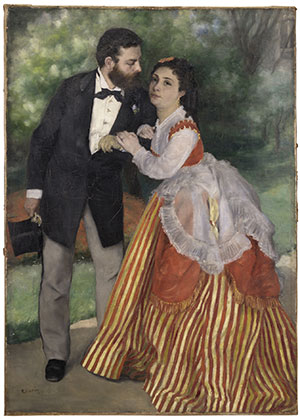Brief Report
For the painting The Couple, formerly known as Mr and Mrs Sisley or The Betrothed, Renoir used a pre-primed canvas that hat already been painted on all over. The first clues to this can be seen under raking light, where the brush-strokes clearly deviate from the visible painting, as well as in a conspicuous network of early shrinkage cracks and cracks due to aging, which already provide a view of the differently coloured underlying paint-layers (fig. 11). That the rejected painting did not survive long before being painted over with the portraits of Alfred Sisley and Lise Tréhot, Renoir’s favourite model, is demonstrated first of all by the broad cracks caused by early shrinkage. But there is also partial wrinkling, predominantly in the green background, which has technical causes and points to inadequate drying of the underlying paint-layers (fig. 8). The X-ray photograph reveals two women sitting facing each other, taking up most of the picture, the size of which remains unchanged (fig. 4). The person on the left, with her hair up and wearing a dress, clearly a woman, is turning away from the beholder, the line of her back clearly visible in Sisley’s sleeve under raking light (fig. 8). A chair with a round back can also be discerned. In the region of her hands the heavy absorption of X-rays by the overpainting prevents us from seeing whether she is reading or occupied with sewing or the like. Under X-rays, the second figure seems to have been less completely executed, the head and narrow-shouldered upper body being shown frontally. All in all, the painting had evidently proceeded to a considerable degree before the depiction of the two women was abandoned for reasons unknown. Two dividing layers, reddish-brown and green, were applied over the whole surface one on top of the other in order to cover the original painting and to provide a neutral ground for the subsequent depiction of the couple (fig. 10). There are no signs of any mechanical reduction of the first picture, such as was Monet’s practice, for example, when revising his pictures [Kendall 2004, p. 120] or such as can be demonstrated in Mary Cassatt’s portrait of little Sara in the collection of the Wallraf-Richartz Museum (WRM Dep. FC 697), which she also intended to revise. In Renoir’s œuvre no picture has to date been identified with the one revealed here by the X-ray picture. Bazille’s 1870 painting of the Studio in the rue Condamine, in the possession of the Musée d‘Orsay in Paris, shows, when X-rayed, a covered-over depiction of Diana with bow and arrow, a motif also painted by Renoir in his 1867 painting Diana the Huntress, 1867, now in the collection of the National Gallery of Art in Washington (figs. 14, 15). Distel does not exclude the possibility that it was a study by Renoir that Bazille over-painted with his depiction of the studio [Distel 1985, p. 180]. As Bazille, Renoir and Monet shared studio premises from time to time between 1866 and 1870 [Néret 2001, p. 431], there were grounds for investigating whether perhaps it was not Bazille or Monet who might have been responsible for the underlying painting. However, to date there is no evidence from the œuvre of either artist to support such a suggestion. The visible painting was executed wet-in-wet throughout, and signed bottom left by Renoir while the paint was still wet. An early fraiming of this painting, whose provanance in the first 30 years of its existance is however unclear, is apparent from pressure marks on the paint layer all round the edge.
Auguste Renoir
born on 25 February 1841 in Limoges,
died on 3 December 1919 in Cagnes
Further illustrations:
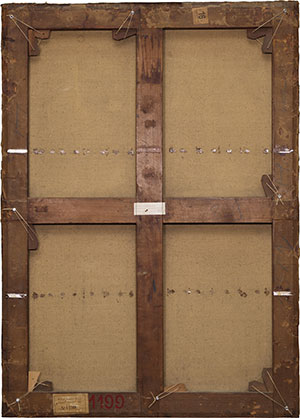
Fig. 02
Verso, lined

Fig. 03
UV fluorescence
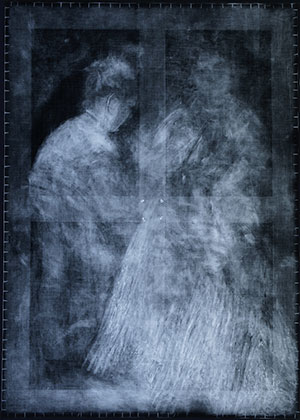
Fig. 04
X-ray
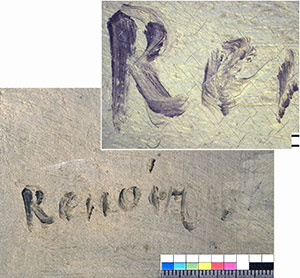
Fig. 05
Detail, signature, wet-in-wet, microscopic photograph (M = 1 mm)
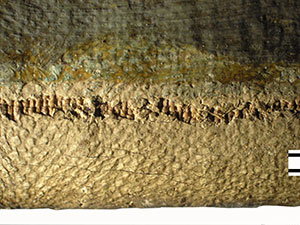
Fig. 06
Priming, at the edges with visible brushwork, microscopic photograph in raking light (M = 1 mm)
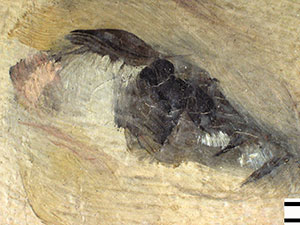
Fig. 07
Wet-in-wet paint applications in the visible picture (Lise
Tréhot’s eye), microscopic photograph (M = 1 mm)
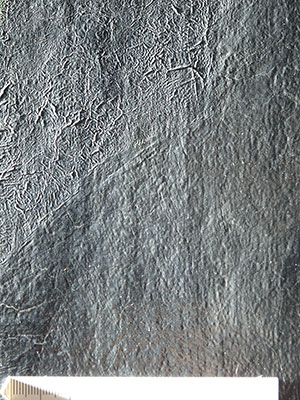
Fig. 08
Detail in raking light, brushwork of the hidden painting and boundary between the network of early shrinkage cracks
and the wrinkling becomes visible (right sleeve of Sisley’s coat)

Fig. 09
Detail of hem of skirt in raking light, brushwork of visible and hidden pictures is apparent
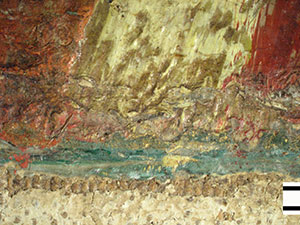
Fig. 10
Overpainted green dividing layer is only partially covered along the foldover edge, microscopic photograph (M = 1 mm)

Fig. 11
Detail, early shrinkage cracks in the green dividing layer on the right next to Lise Tréhot allows us to see an underlying red paintlayer which belongs to the dress of the covered
right-hand figure, microscopic photograph (M = 1 mm)
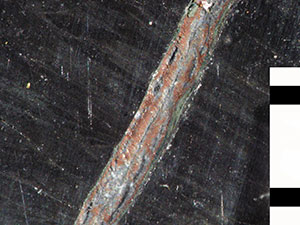
Fig. 12
Early shrinkage crack; investigation of the stratigraphy reveals, from top to bottom: visible black paint-layer
(Sisley’s coat, second use of canvas), green and reddish-brown dividing layers, grey paint-layer (dress of left-hand woman, first use of canvas), microscopic photograph
(M = 1 mm)

Fig. 13
Photo-collage of visible painting and X-ray, with mapping of the paintedover picture of the two women
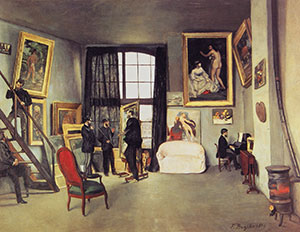
Fig. 14
Frédéric Bazille, Atelier dans la rue Condamine, 1870,
h 98.0 x b 128.0 cm, Musée d'Orsay, Paris
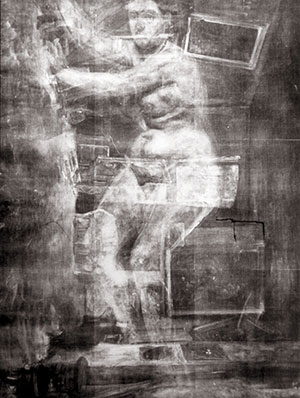
Fig. 15
X-ray picture of fig. 14 (rotated through 90°), rejected Diana motiv is visible

